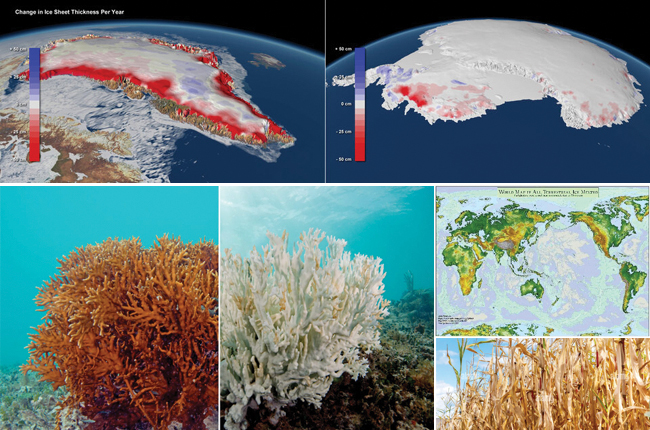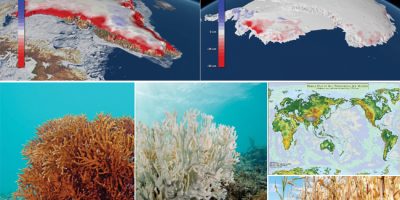69
Climate change is one of the most pressing issues in the modern world due to its global impact. Climate change refers to as long-term alterations in global or regional climate patterns, particularly an increase in global average temperature. Also, climate change can be described as significant and lasting changes in the Earth’s climate system, primarily driven by natural processes and human activities.
Although climate change is not a recent phenomenon, Earth’s climate has changed naturally over millions of years due to various factors, such as volcanic activity, changes in Earth’s orbit, and solar radiation. However, the increased gas emissions caused by human activities have greatly accelerated the rate of change we are currently experiencing. This is known as ‘anthropogenic climate change’.
Over the past century, the planet has experienced unprecedented changes, including rising global temperatures, melting polar ice caps, shifting weather patterns and an increase in extreme weather events.
The primary cause of recent climate change is the accumulation of greenhouse gases (GHGs) such as carbon dioxide (CO₂), methane (CH₄), and nitrous oxide (N₂O) in the atmosphere, largely due to human activities like burning fossil fuels, deforestation, and industrial processes. These gases trap heat, leading to a phenomenon known as the greenhouse effect, which contributes to global warming.
Understanding climate change is crucial, not only because of its environmental impacts but also due to its profound effects on ecosystems, economies, and human societies. Rising sea levels threaten coastal communities, ocean acidification, changing precipitation patterns, disrupt agriculture, and biodiversity loss endangers the balance of natural ecosystems.
Impacts of Climate Change
Rising Temperatures and Global Warming
One of the most significant consequences of climate change is the increase in global temperatures. As mentioned in the earlier greenhouse gasses are the main contributor for the temperature rising. Combustion of fossil fuels, industrial activities, vehicle emission are the main sources of carbon emission. The Earth’s average surface temperature has risen by approximately 1.2°C since pre-industrial times, with projections suggesting that it could increase by an additional 1.5°C to 4°C by the end of the 21st century, depending on emission scenarios1. The Paris Agreement adopted at the United Nations Climate Change Conference (COP21) in 2015 emphasizes the need to limit global temperature increases to 1.5°C above pre-industrial levels by 2030.
Challenges:
High air temperatures can leads to heat-related illnesses, wildfires, and damage to agriculture, infrastructure, and ecosystems. They can also produce large-scale and long-lasting marine heat waves as the oceans absorb atmospheric heat, resulting in disturbances in marine ecosystems such as mass coral bleaching.
Warming is especially pronounced in polar areas, leading to ice melt and contributing to sea-level rise.

Increased temperatures exacerbate respiratory conditions, cardiovascular diseases, and vector-borne diseases (e.g., malaria, dengue).
Extreme Weather Events
As global temperatures rise, the frequency and intensity of extreme weather events, such as hurricanes, floods, droughts, and wildfires, are becoming more pronounced. These events have devastating consequences for communities, particularly in vulnerable regions.
Challenges:
Heavy Rainfall and Flooding:

Warmer temperatures increase the amount of moisture in the atmosphere, leading to more intense rainfall events. This can result in more frequent and severe floods, damaging property and infrastructure and causing loss of life. Annually, LKR 32 billion will lose due to flooding in Sri Lanka2.
Extended drought periods, exacerbated by higher temperatures, are threatening water availability, agricultural production, water resources and ecosystems. Due to drought Sri Lanka lost LKR 5.2 billion annually2.

In regions like California, Australia, and the Mediterranean, longer fire seasons and more intense fires are becoming the norm.
- Hurricanes and tropical storms
Warmer ocean surface waters can fuel the intensity of hurricanes and tropical storms, making them more destructive with stronger winds, storm surges, and heavy rainfall.
Sea-Level Rise

Sea level rise refers to the long term increase in the average level of the world’s oceans and is primarily caused by two factors: melting of glaciers and thermal expansion of seawater.
As planet Earth warms, 90% of that heat is absorbed by the oceans, resulting in rising ocean temperatures and thermal expansion of seawater, leading to an increase in sea level. Additionally, the melting of glaciers and ice sheets on land, such as those in Antarctica and Greenland, adds more water to the oceans, further contributing to sea level rise. The phenomenon of sea level rise is considered one of the major consequences of climate change and is a growing concern for many coastal regions around the world. It is predicted that by 2050 several cities can be sunk due to sea level rising, namely New York, Dhaka, Mumbai, Shanghai.
Moreover, the Sri Lanka’s sea level is projected to rise by about 0.1-0.2 meters by 2071 and about 0.7 m by 2221, which could lead to widespread beach erosion, flooding, storm surges and inundation of adjacent lowlands and wetlands3. ….
Challenges:
- Coastal Erosion: Cities such as Miami, New York, and Venice are already facing significant challenges from rising seas.
- Displacement: Due to sea level rising coastal population lost their own locations and may need to relocate them. It creates climate refugees.
- Biodiversity Loss: Coral reefs, mangroves, and coastal ecosystems are at risk, with consequences for marine biodiversity and livelihoods.
Loss of Biodiversity and Ecosystem Disruption
Climate change is contributing to significant disruptions in ecosystems, including the extinction of species, the loss of habitats, and shifts in biodiversity. Many species are unable to adapt quickly enough to changing climatic conditions, leading to imbalances in ecosystems.
Challenges:
- Extinctions: Temperature increase leads to habitat loss, and changing migratory patterns of the species. It will threaten to species survival.
- Ocean Acidification: The pH of the sea water decreases due to absorption of CO2 from the atmosphere. This chemical imbalance and altering the chemistry of the sea water negatively affect marine life, particularly coral reefs and shellfish, which occur coral bleaching.
- Shifting Habitats: Species are migrating to new areas, creating ecological disruptions and potential conflicts between human activities and wildlife.

Social and Economic Impacts
The effects of climate change are not only environmental but also deeply social and economic. Disparities between rich and poor nations exacerbate the impacts of climate-related disasters.
Challenges:
- Poverty and Inequality: Vulnerable communities in the Global South face disproportionate impacts, with fewer resources for adaptation.
- Food Security: Agricultural production is being disrupted by unpredictable weather patterns, droughts, and floods, threatening global food supply chains.
- Economic Losses: Infrastructure damage from extreme weather events and the cost of adaptation efforts are straining economies, especially in developing nations.
Mitigation and Adaptation Strategies
Addressing the challenges of climate change requires both mitigation (reducing GHG emissions) and adaptation (adjusting to its effects). International agreements such as the Paris Agreement emphasize the importance of limiting global warming to well below 2°C.
Mitigation Strategies:
- Renewable Energy: Transitioning to solar, wind, and other renewable energy sources to reduce fossil fuel reliance.
- Carbon Capture: Developing technologies that capture and store CO2 emissions.
- Reforestation and Conservation: Protecting and restoring forests, wetlands, and other carbon sinks.
Adaptation Strategies:
- Resilient Infrastructure: Designing cities and infrastructure to withstand extreme weather events and rising seas.
- Water Management: Implementing policies for efficient water use and conservation, especially in drought-prone areas.
- Community-Based Adaptation: Engaging local communities in developing adaptation plans tailored to their specific needs and vulnerabilities.
Policy and Global Cooperation
Tackling climate change is a global challenge that requires coordinated efforts. International agreements such as the United Nations Framework Convention on Climate Change (UNFCCC) and the Paris Agreement have set ambitious goals; however, progress has been slow due to political, economic, and social factors. The Paris Agreement outlines important targets, but its lack of enforcement mechanisms to hold countries accountable remains a significant limitation.
Policy gaps also hinder effective climate policy implementation. Challenges such as political opposition and conflicting economic interests prevent meaningful action. Many countries prioritize economic growth without adequately considering the long-term impacts of climate change. As a result, climate justice is essential to ensure equitable solutions that address the disproportionate impacts of climate change on developing nations and marginalized communities.
To overcome the challenges of climate change, it is crucial to strengthen international collaboration, integrate climate considerations into economic policies, and embrace equity. These efforts are vital for mitigating climate impacts and ensuring a fair and sustainable future for all.
Finally, climate change represents one of the most significant challenges humanity has ever faced. The urgency of addressing this crisis has never been clearer. While formidable obstacles remain, there is also immense potential for innovative solutions. By focusing on mitigation, adaptation, global collaboration, and a commitment to sustainability, humanity can work toward a future that safeguards the planet for generations to come.

K A Diane Amalika (MSc. Applied Organic Chemistry)
Environmental Officer
Central Environmental Authority
Sources;
https://www.climate.gov/news-features/understanding-climate/climate-change-global-temperature
Geo-environmental Disasters | SpringerOpen (springeropen.com)](https://geoenvironmental-disasters.springeropen.com/articles/10.1186/s40677-020-00154-y
https://www.climate.gov/news-features/understanding-climate/climate-change-global-temperature
Climate Change: Global Sea Level | NOAA Climate.gov (climate.gov)]
(https://www.climate.gov/news-features/understanding-climate/climatechange-global-sea-level )
Carbon dioxide at sea | Science in School (scienceinschool.org)](https://www.scienceinschool.org/article/2021/carbon-dioxide-at-sea/ )














